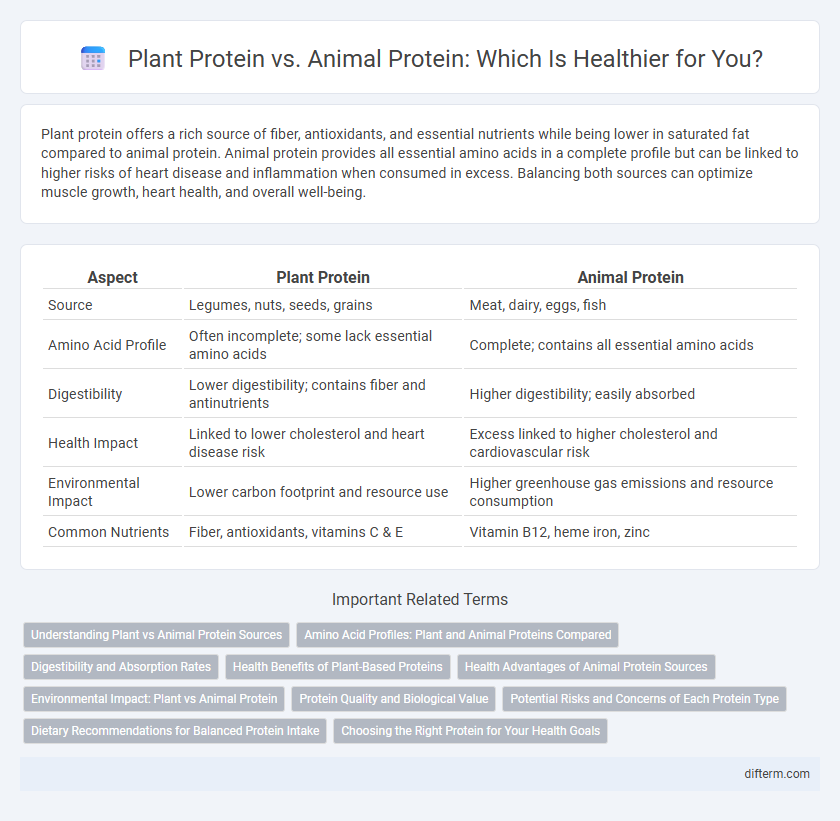Plant protein offers a rich source of fiber, antioxidants, and essential nutrients while being lower in saturated fat compared to animal protein. Animal protein provides all essential amino acids in a complete profile but can be linked to higher risks of heart disease and inflammation when consumed in excess. Balancing both sources can optimize muscle growth, heart health, and overall well-being.
Table of Comparison
| Aspect | Plant Protein | Animal Protein |
|---|---|---|
| Source | Legumes, nuts, seeds, grains | Meat, dairy, eggs, fish |
| Amino Acid Profile | Often incomplete; some lack essential amino acids | Complete; contains all essential amino acids |
| Digestibility | Lower digestibility; contains fiber and antinutrients | Higher digestibility; easily absorbed |
| Health Impact | Linked to lower cholesterol and heart disease risk | Excess linked to higher cholesterol and cardiovascular risk |
| Environmental Impact | Lower carbon footprint and resource use | Higher greenhouse gas emissions and resource consumption |
| Common Nutrients | Fiber, antioxidants, vitamins C & E | Vitamin B12, heme iron, zinc |
Understanding Plant vs Animal Protein Sources
Plant protein sources such as beans, lentils, quinoa, and soy provide essential amino acids and are rich in fiber, antioxidants, and phytochemicals that support overall health. Animal proteins from meat, dairy, and eggs typically offer complete proteins with all nine essential amino acids and are high in bioavailable nutrients like vitamin B12, iron, and zinc. Understanding the nutritional differences between plant and animal proteins helps optimize dietary choices for muscle maintenance, metabolic health, and disease prevention.
Amino Acid Profiles: Plant and Animal Proteins Compared
Plant proteins often lack one or more essential amino acids, making it important to consume a variety of sources like legumes, grains, and nuts to achieve a complete amino acid profile. Animal proteins, such as meat, dairy, and eggs, naturally contain all nine essential amino acids in optimal ratios, supporting muscle repair and overall body function more efficiently. Combining different plant proteins throughout the day can provide a similar amino acid profile to animal proteins, benefiting individuals following vegetarian or vegan diets.
Digestibility and Absorption Rates
Plant protein generally has lower digestibility and absorption rates compared to animal protein due to the presence of anti-nutritional factors such as fiber and phytates that inhibit enzyme access. Animal proteins, found in sources like meat, eggs, and dairy, contain all essential amino acids and exhibit higher bioavailability, often exceeding 90%. Methods like fermentation and processing can improve plant protein digestibility, yet they typically remain less efficient than animal-derived proteins in supporting muscle synthesis and recovery.
Health Benefits of Plant-Based Proteins
Plant-based proteins are rich in essential nutrients, fiber, antioxidants, and phytochemicals that support heart health and reduce inflammation. Sources like legumes, nuts, and seeds provide high-quality protein that aids in muscle repair while promoting lower cholesterol levels and better weight management. Consuming plant proteins is associated with a reduced risk of chronic diseases including type 2 diabetes, hypertension, and certain cancers.
Health Advantages of Animal Protein Sources
Animal protein sources provide all essential amino acids in optimal ratios, promoting muscle repair and growth effectively. They are rich in bioavailable nutrients such as vitamin B12, heme iron, and omega-3 fatty acids, which support cognitive function, red blood cell production, and cardiovascular health. Compared to plant proteins, animal proteins generally have higher digestibility and enhance nitrogen retention, contributing to improved overall metabolic health.
Environmental Impact: Plant vs Animal Protein
Plant protein production generates significantly lower greenhouse gas emissions compared to animal protein, reducing the overall carbon footprint associated with dietary choices. It also requires less water and land resources, contributing to more sustainable food systems and decreased habitat destruction. Transitioning to plant-based proteins supports environmental conservation by minimizing pollution and promoting biodiversity.
Protein Quality and Biological Value
Plant protein generally has a lower biological value compared to animal protein due to its incomplete amino acid profile and lower digestibility. Animal proteins, such as whey, eggs, and meat, provide all essential amino acids in optimal ratios, resulting in higher protein quality and muscle synthesis efficiency. Combining various plant sources like legumes, grains, and seeds can enhance protein quality, approaching that of animal proteins through complementary amino acid profiles.
Potential Risks and Concerns of Each Protein Type
Plant protein sources may contain antinutrients such as phytates and lectins, which can impair mineral absorption and cause digestive discomfort in sensitive individuals. Animal protein consumption is linked to higher intake of saturated fats and cholesterol, potentially increasing the risk of cardiovascular disease and certain cancers. Both protein types require balanced consumption to mitigate risks related to nutrient bioavailability and long-term health outcomes.
Dietary Recommendations for Balanced Protein Intake
Dietary recommendations emphasize balancing plant and animal protein sources to optimize health benefits and nutrient intake. Plant proteins provide fiber, antioxidants, and lower saturated fat, while animal proteins offer complete amino acid profiles and essential micronutrients like vitamin B12 and iron. Combining diverse protein sources supports muscle synthesis, cardiovascular health, and sustainable dietary patterns.
Choosing the Right Protein for Your Health Goals
Plant protein sources like legumes, nuts, and quinoa offer fiber, antioxidants, and essential vitamins that support heart health and weight management. Animal proteins provide complete amino acids and higher bioavailability, which are critical for muscle growth and repair. Selecting the right protein depends on individual health goals such as muscle building, cardiovascular health, or dietary restrictions like veganism or lactose intolerance.
Plant Protein vs Animal Protein Infographic

 difterm.com
difterm.com